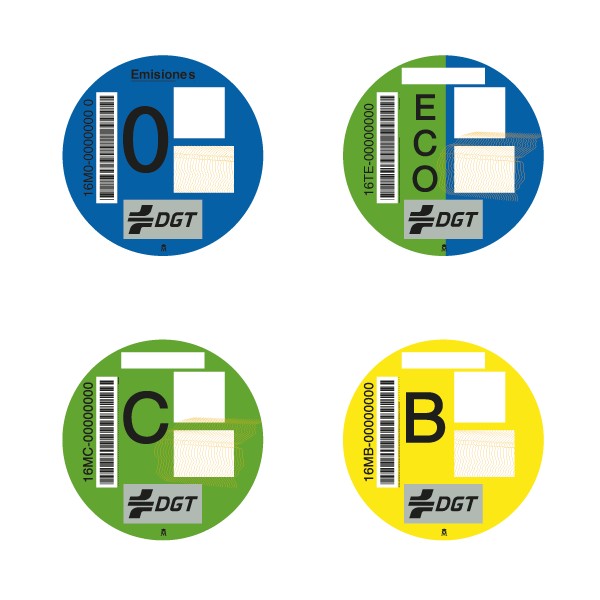We have been speaking a lot about the necessity to obtain an eco sticker for your vehicle, El Distintivo Ambiental DGT to give it the full name in Spanish, as Low Emission Zones are being implemented in most Spanish towns and cities, and you will face a fine if you enter one of these zones without the sticker in your windscreen.
We thought it also a good idea to explain a little more about the actual characteristics, categories and definitions of these eco stickers, so you understand them a little better.
The DGT Environmental Badge, El Distintivo Ambiental DGT, is a label that quickly identifies the most environmentally friendly vehicles. It must be placed in the lower right corner of the windshield, looking out, and, although it is voluntary, it is recommended, as you will be fined if you accidentally drive into a Low Emission Zone without the sticker on display.
The eco sticker is also referred to as the environmental badge, and is a way of classifying vehicles based on their energy efficiency, taking into account their environmental impact.
The purpose of the classification is to positively discriminate the most environmentally friendly vehicles and to be an effective instrument at the service of municipal policies, both restrictive of traffic in episodes of high pollution, and of promoting new technologies through benefits fiscal or related to mobility and the environment.
The eco sticker itself is formed of adhesive material, has a diameter of 97mm in the version to be displayed on cars and vans, and 87mm for the version for motorcycles.
There are four types of badge, which are issued depending on the polluting potential of the vehicle:
Distintivo cero emisiones, the zero emissions label, which is coloured blue, and applies to:
- Battery Electric Vehicles (BEV).
- Electric vehicles with extended range (REEV).
- Plug-in hybrid electric vehicles (PHEV) with a minimum range of 40 km.
- Fuel cell vehicles.
Distintivo eco, or the eco badge, this is coloured green and blue, and applies to:
- Plug-in hybrid vehicles with a range of less than 40 km.
- Non-plug-in hybrid vehicles (HEV).
- Vehicles powered by natural gas.
- Vehicles powered by natural gas (CNG and LNG) or liquefied petroleum gas (LPG).
Distintivo C, or distinctive C, a green-coloured sticker that applies to:
- Passenger cars and light petrol vans, registered from January 2006.
- Passenger cars and light diesel vans registered from 2014.
- Vehicles with more than 8 seats and heavy, petrol or diesel, registered from 2014.
Petrol vehicles must comply with the Euro 4.5 and 6 standard, and diesel vehicles with Euro 6.
Distintivo B, or distinctive B, a yellow sticker that applies to:
- Passenger cars and light petrol vans registered from January 2000.
- Diesel passenger cars and light vans registered from January 2006.
- Vehicles with more than 8 seats and heavy, petrol or diesel, registered from 2005.
Petrol vehicles must comply with the Euro 3 standard, and diesel vehicles with Euro 4 and 5.
There are two types of labels which are designed for motorcycles and other similar vehicles, but they all have the same cost:
Two and three-wheeled mopeds with a cylinder capacity of less than 50 cm³ if internal combustion and a maximum speed of no more than 45 km/h.
Light quadricycles with an empty mass of less than 350 kg (not including the mass of the batteries in the case of electric vehicles), a maximum speed of not more than 45 km/h, a displacement of less than or equal to 50 cm³ for internal combustion engines or a power equal to or less than 4 kW for other types of motors.
Two-wheeled motorcycles with or without a sidecar with a displacement greater than 50 cm³, if it is internal combustion, and a maximum speed greater than 45 km/h.
On a motorcycle, the eco sticker must be displayed in a visible location, as many of them do not have a windscreen. You can purchase a special holder, similar to the tax disk holder that used to be used in the UK, but this is not mandatory, only that the sticker must be visible.
If you want to check what category your vehicle falls into, the DGT has a tool on their website where you can input your vehicle registration number and click “Consultar”, and the site will tell you the category you fall into. That tool is available at https://sede.dgt.gob.es/es/vehiculos/distintivo-ambiental#
We have already explained how you can obtain your eco sticker from the main post office network, the easiest option, but you can also obtain one through workshops of the Spanish Confederation of workshops (CETRAA) and other networks of authorised workshops, Gestores Administrativos, the Institute of Automotive Studies (IDEAUTO) and in the case of fleets, you can obtain the badges through the Ganvam association.






